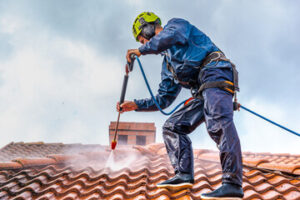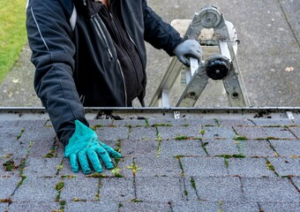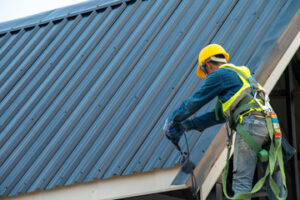Invisible but vital, roof cleaning helps to extend the lifespan of a home’s shingles while protecting your investment. This service removes damaging algae, moss, grit and other debris.

Professionals use a safe and effective cleaning solution that is applied and allowed to dwell before being rinsed. This method is known as soft wash. Contact Roof Cleaning Charleston SC for professional help.
Algae, moss, and mold can be problematic for roofs in humid areas. These organisms thrive in dark, damp conditions and can cause a host of problems for your home’s structure. In addition to their unsightly appearance, they can also lead to rot, mildew, and leaks. Fortunately, these organisms are fairly easy to identify and remove from your roof. Algae creates dark streaks while moss and mold have green or fuzzy appearances.
If a roof is heavily covered with moss, it’s important to get it cleaned before it damages the shingles. Moss grows in a sponge-like fashion and can dig into the shingles and surrounding structures, causing them to deteriorate over time.
While some moss can be removed with a simple brush and a garden hose, most professionals recommend using a specialized moss-removal cleaning solution. These solutions usually contain bleach, sodium hypochlorite, or other chemicals that are effective at killing moss but are gentle enough to avoid damaging the shingles. In most cases, a diluted mixture of these chemicals can be applied with a garden sprayer and left to stand for 20-30 minutes before being rinsed. When applying any moss cleaner, it is best to work on a cloudy day to prevent the liquid from evaporating too quickly.
Once the moss has been effectively killed, a long-handled broom can be used to gently brush away the dead organisms. This should be done in small, circular motions to avoid causing any damage or lifting the shingles. Depending on the severity of the problem, repeated treatments may be necessary.
While algae and moss are difficult to prevent, regular maintenance can go a long way towards keeping your roof free from unwanted growth. Trimming tree branches that overhang the roof and repairing any leaks or punctures will help keep moisture from seeping onto the roof and encouraging unwanted growth. Adding copper or zinc strips near the roof’s peak can also help prevent moss and algae from growing because these metals release natural agents that deter unwanted growth. These preventative measures are relatively inexpensive and can be done by a roofing professional.
Stains Removal
Roof stains from mildew, moss, or algae can be unsightly and damaging to the underlying material. Regular cleaning removes these stains and prevents them from returning, improving your home’s curb appeal, energy efficiency, and longevity. Regular cleaning also reveals problem areas that might need repair, protecting the integrity of your home and preventing costly water damage.
The first step in stain removal is identifying the type of buildup to determine the appropriate cleaning method. The best approach is soft washing, which uses low-pressure water combined with cleaning solutions to break down grime without damaging shingles or other materials on your roof. This process involves spraying the solution evenly across the surface and allowing it to sit, removing dirt, mold, mildew, fungus, and other organisms before rinsing off.
Mold Removal
Mold on a roof is not only unsightly, but it can lead to serious structural damage if left untreated. It also provides an inviting habitat for rodents such as rats and squirrels, who can chew through weakened roofing materials to create nests. These rodents can cause further damage to the structure of your home and may require costly roof repair or even a replacement.
The best way to get rid of mold is to use a chemical solution, such as chlorine bleach. You should follow the product instructions carefully to make sure you use it correctly and safely. Before applying the solution, you should sweep the area to remove any dirt or debris that might be stuck on the surface of the shingles. Next, you should scrub the affected areas with a brush or non-abrasive cleaning pad. Be sure to work in small sections and to avoid scrubbing too hard, as this can damage the shingles. Some people suggest adding trisodium phosphate (TSP) to the bleach mixture to increase its strength and cleaning power.
When the solution has had a chance to soak into the affected shingles for several minutes, you should rinse it off with a garden hose. Be careful not to over-rinse, as this can strip the granules from the shingles and make them vulnerable to further damage. If you see any signs of mold returning, repeat the process as needed to keep it under control.
A mold-free roof will be less susceptible to stains and other damage, so it is well worth the investment of time and money to get it cleaned as needed. Some additional steps you can take to prevent mold growth include trimming overhanging trees that create shade and moisture, ensuring there is adequate ventilation in your attic, and regularly cleaning gutters.
Once your roof is free of algae, moss, and mold, you should consider having it sealed to protect the shingles from future growth and staining. It is important to have the sealant applied during a dry and warm period, as this will ensure that it has a chance to fully cure and do its job.
Low-Pressure Rinsing
Keeping the exterior of your home clean is important for both maintaining your property’s curb appeal and preventing costly repairs. Soft washing is an environmentally friendly cleaning method that removes mildew, mold, moss, and other organic growths from your roof, as well as from other building materials like wood, stucco, and vinyl siding. This cleaning technique uses low pressure and biodegradable cleaners to safely wash away grime, avoiding damage to delicate surfaces.
The preparation process for soft washing starts with a thorough inspection of the area to identify potential areas that may require additional attention, like loose or damaged shingles. Then, the surrounding area is prepared to protect plants, windows, and other items that could be damaged by high water pressure during the cleaning process. Delicate plants are protected with tarps, and patio furniture and cars are moved so they can’t be harmed by the cleaning solution or by the rinsing water. Once the cleaning process begins, the cleaning solution is applied and allowed to soak for the recommended period, which can be between 10 and 20 minutes depending on the product’s instructions.
After the soaking time, the roof is gently rinsed with low pressure to remove the cleaning solution and dead organic growth. Then, a final rinsing with fresh water removes any remaining debris. If any tough stains remain, the cleaning agent can be reapplied and left to soak again for a longer period of time, before being rinsed and dryed thoroughly with low pressure.
Once the cleaning and rinsing are complete, a post-treatment with a neutralizing solution is used to protect plant life and help prevent future growth. Then, a light application of the biodegradable cleaning solution can be used to keep your home and roof cleaner for longer than traditional high-pressure cleaning.
Having regular maintenance performed, like trimming overhanging trees and clearing gutters, can help prevent the buildup of dirt and stains. Also, regularly scheduled professional cleaning services can make sure your roof stays clean and healthy. Combined with routine cleaning of driveways and sidewalks, homeowners can guarantee that their home’s exterior always looks its best.


